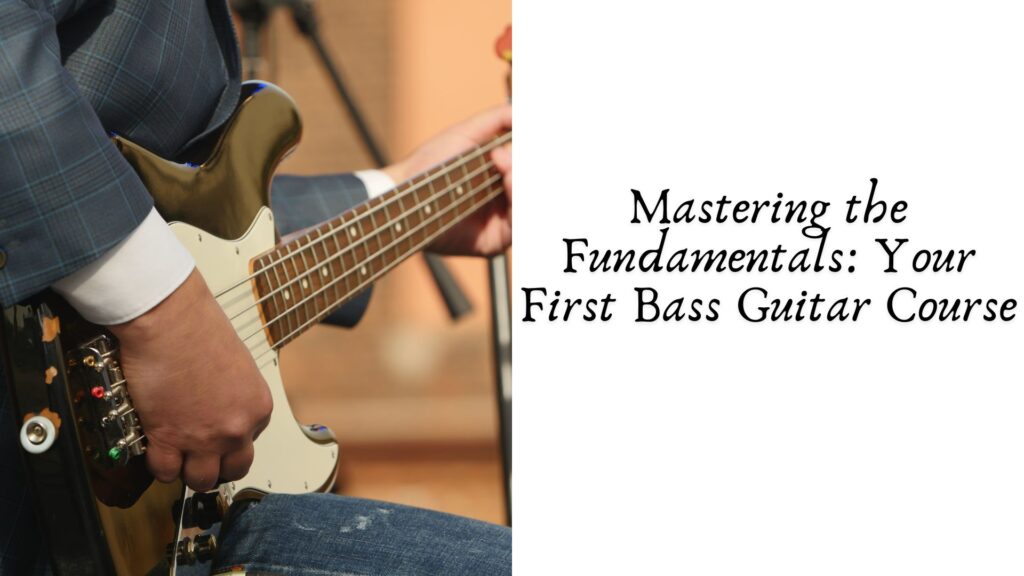
Learning to play the bass guitar is an exciting journey that opens the door to a world of rhythm, groove, and musical creativity. Whether you’re an aspiring musician looking to join a band or simply want to play for fun, mastering the fundamentals is crucial to becoming a proficient bassist. This guide will walk you through the essentials of your first bass guitar course, helping you build a strong foundation for your musical journey.
Choosing the Right Bass Guitar
Before you start playing, selecting the right bass guitar is important. There are various types of bass guitars, including four-string, five-string, and fretless models. Beginners typically start with a four-string bass as it is easier to learn and widely used in different music genres. Pay attention to the weight, neck shape, and string spacing to ensure comfort and ease of playability.
Understanding the Anatomy of a Bass Guitar
Familiarizing yourself with the different parts of a bass guitar will help you understand how the instrument works. Key components include:
- Body: The main structure that houses the pickups and controls.
- Neck: The long part of the guitar where you press the strings to change notes.
- Frets: Metal strips on the fingerboard that help you play specific notes.
- Pickups: Magnetic components that capture string vibrations and convert them into sound.
- Bridge: Holds the strings in place and transmits their vibrations.
- Tuning Pegs: Adjust string tension to keep the instrument in tune.
Tuning Your Bass Guitar
Proper tuning is essential for sounding good while playing. The standard tuning for a four-string bass is E-A-D-G, from the lowest to the highest string. Use an electronic tuner or a tuning app to ensure accuracy. Regular tuning checks will help train your ear and maintain consistency in your playing.
Developing Proper Playing Technique
A solid technique is fundamental to producing clear and controlled notes. Here are some key elements:
- Hand Positioning: Your fretting hand should be relaxed, with fingers pressing the strings just behind the frets for a clean sound.
- Plucking Technique: You can use your fingers or a pick to pluck the strings. The most common method for bassists is alternating index and middle fingers.
- Posture: Sit or stand with a straight back and keep your bass at a comfortable height using a strap.
Learning Basic Music Theory
Understanding basic music theory will improve your ability to learn and play songs effectively. Some essential concepts include:
- Notes on the Fretboard: Memorize the notes on the E and A strings to navigate the fretboard more easily.
- Scales: The major and minor scales are foundational for creating basslines.
- Chord Progressions: Recognizing common chord patterns will help you play along with songs.
Playing Your First Basslines
Once you’ve got the basics down, start practicing simple basslines. Some beginner-friendly songs include:
- “Smoke on the Water” – Deep Purple
- “Seven Nation Army” – The White Stripes
- “Another One Bites the Dust” – Queen Practicing with a metronome will help you develop a steady rhythm, which is essential for bass playing.
Practicing with a Band or Backing Tracks
Bassists play a crucial role in a band’s rhythm section, so practicing with backing tracks or jamming with other musicians will improve your timing and musicality. Online resources like YouTube and apps such as GarageBand offer excellent tools for play-along practice.
Building Strength and Dexterity
Daily exercises will enhance your finger strength and coordination. Try practicing:
- Finger Independence Drills: Play chromatic scales up and down the fretboard.
- String Crossing Exercises: Move smoothly between strings while maintaining control.
- Slap and Pop Techniques: Learn funk-style techniques to add variety to your playing.
Maintaining Your Bass Guitar
Taking care of your bass will ensure it stays in good condition. Key maintenance tips include:
- Wiping the strings and fretboard after playing to remove dirt and oil.
- Keeping your bass in a protective case when not in use.
- Changing strings periodically to maintain sound quality.
- Checking the neck and adjusting the truss rod if needed for optimal playability.
Conclusion
Mastering the fundamentals of bass guitar playing requires patience, dedication, and consistent practice. By choosing the right instrument, developing proper techniques, and building a strong foundation in music theory, you’ll be well on your way to becoming a skilled bassist. Keep practicing, stay motivated, and most importantly, enjoy the process of making music!





